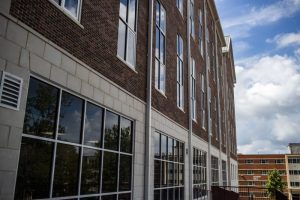ATF unit helps local law enforcement work through cases
Published 12:15 am Sunday, June 13, 2021

- Warren County Sheriff’s Office Detective Robert Smith (left) receives ammunition from WCSO Detective Evan Cook as WCSO Detective Vedad Hadzikadunic completes paperwork Friday in the Bowling Green Police Department parking lot.
In the space of about a week, the Warren County Sheriff’s Office cut a swath through a backlog of criminal cases in which guns were confiscated using a tool developed by the U.S. Bureau of Alcohol, Tobacco, Firearms and Explosives that could help generate leads in more criminal cases.
The ATF brought its National Integrated Ballistic Information Network Mobile Unit to Bowling Green last week.
Trending
Established in 1997, NIBIN provides local law enforcement with a nationwide network that allows for the capture and comparison of ballistic evidence that can help solve crimes involving firearms.
Three ATF NIBIN mobile units are based in Kentucky – in Louisville, Lexington and Madisonville.
On Friday, ATF officials and local law enforcement held a demonstration of the mobile unit at Bowling Green Police Department headquarters.
Warren County Sheriff’s Office detectives brought guns that had been collected from various criminal investigations to the mobile unit.
WCSO Detective Robert Smith test-fired each weapon into a specially-designed bullet trap set up in a trailer towed by the mobile unit.
Images of each fired round are loaded into the NIBIN database.
Trending
Spent rounds feature striations, or markings, on their surface created by the grooves inside the barrel of a gun.
NIBIN can be used to collect and compare digital scans of guns and cartridge casings found at crime scenes across the country.
Comparison of newly submitted images to existing images can allow law enforcement to identify potential links between firearm-related crimes in separate jurisdictions.
“I can relate this to a fingerprint database, but it’s for guns,” WCSO Chief Deputy Kevin Wiles said. “If a particular weapon has been involved in a crime somewhere else, we may have a chance of developing a lead on another crime it was used in.”
If a lead is generated, a firearms examiner will conduct a microscopic examination of the physical evidence in an effort to confirm a match.
Wiles said the sheriff’s office entered about 60 guns collected from several investigations into the NIBIN database in the past week.
“This was a special occasion for us and we’re trying to take advantage of it by prioritizing cases that we need to get into the system to develop leads,” Wiles said.
In addition to advancing ongoing investigations, the mobile unit has allowed WCSO investigators to become more familiar with the process of entering ballistics evidence and to strengthen relationships with the ATF and other federal agencies.
In all, an estimated 4.2 million pieces of evidence and about 45 million images are stored in NIBIN.
In 2019 alone, 67,000 leads were generated by 220 NIBIN locations and 450,000 guns used in crimes were traced back to their origins by the agency’s National Tracing Center, according to ATF.
“Crime gun intelligence is definitely a game changer when it comes to solving a violent crime, and NIBIN is a pillar to crime gun intelligence along with firearms tracing,” said Tommy Estevan, assistant special agent in charge of the ATF’s Louisville field division. “This is linking shooting events that cross jurisdictional lines that we may not have known about without the NIBIN.”







